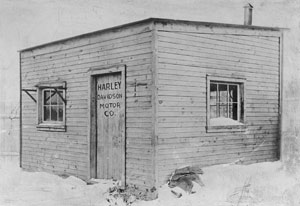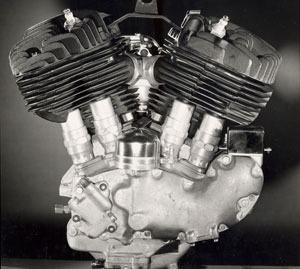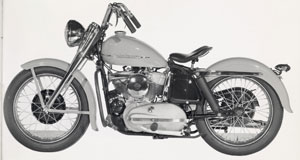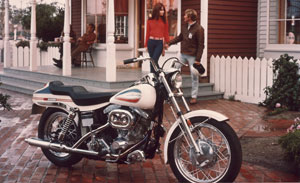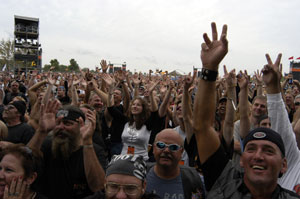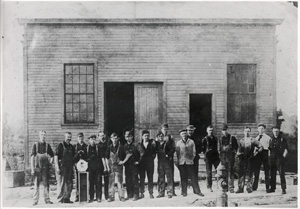
Back to Motorcycle Review Page
Harley-Davidson Motorcompany History and Background
Page 11 of 12
<< Page Back – Page Forward >>
A little Harley-Davidson history and background.

Harley-Davidson, as many of you already know, is a premier motorcycle manufacturer that has been creating motorcycles since 1903.
1900-1920’s From humble beginnings to the largest motorcycle manufacturer in the world…
Harley-Davidson is a true American story rich with heritage. William C. Davidson, Harley-Davidson’s original founder, started building motorcycles in a 10×15′ wooden shed in his backyard. 9 years later the growing company built a six story headquarters and main factory building at Juneau Ave. in Milwaukee. By World War One almost half of all Harley-Davidson motorcycles produced were sold for use by the U.S. military during the war. By war’s end, it is estimated that the Army used some 20,000 motorcycles in their efforts, most of which were Harley-Davidson’s.
By 1920, Harley-Davidson was the largest motorcycle manufacturer in the world. New Harley-Davidson motorcycles could be purchased from over 2,000 dealers in 67 countries worldwide. In 1929 the 45 cubic inch V-Twin engine (later to be known as the “flathead”) was introduced on the D model. The engine proved to be so reliable that variations of it became available on Harley-Davidson motorcycles as late as 1973.
The 1930-1940’s – W.W.II and Just 2 left…
In 1931 all of Harley-Davidson’s remaining American competition is now gone except Indian (Hendee Manufacturing). These two manufacturers are the only two American motorcycle manufacturers until 1953. By 1935 Joe Petrali and his Harley-Davidson peashooter won all thirteen of the American Motorcycle Association National Championship dirt track races. Petrali broke four records in the process.
In 1945 Harley-Davidson produced almost 60,000 WLA models during the war for military use. World War II ends. Wasting no time, production of civilian motorcycles resumed in November. In 1946 Harley-Davidson introduces the 45 cubic inch flathead WR racing motorcycle. It proved to be one of the best racing motorcycles ever built. In 1947 Harley-Davidson begins selling what will become the classic black leather motorcycle jacket.
1950’s – Beginning of a modern era
In 1952 the side-valve K model was introduced with an integrated engine & transmission to compete with smaller, sportier motorcycles coming mainly from Great Britain. The K would eventually evolve into the Sportster.
In 1955 a seven-year consecutive run of victories at the Daytona 200 began. The victories were shared by racers Brad Andres, Johnny Gibson, Joe Leonard and Roger Reiman, all who ride Harley-Davidson KR models. Reiman’s victory in 1961 was on the new speedway course. In 1956 the new young star Elvis Presley poses for the cover of the May Enthusiast sitting on a 1956 model KH. In 1957 the motorcycling public met a new motorcycle called the Sportster. It premiered as a 55 cubic inch overhead valve engine, and within one year of its debut, became known as the first of the “Superbikes.” Another Harley-Davidson tradition and legend is born. In 1958 the first rear brakes and hydraulic rear suspensions appeared on the Duo-Glide.
1960’s – Race, speed, production and the AMF
In 1965 the Electra-Glide replaced the Duo-Glide and was updated with an electric starter. The Electra-Glide was the first FL available with electric start, and the Sportster line received electric starters soon after.
|
|
||
|
..
|
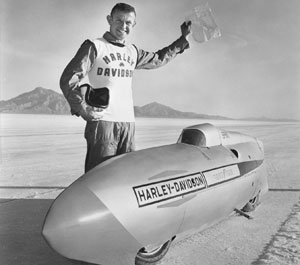 |
.. |
|
George Roeder (1965)
In a Streamliner powered by a 250cc Sprint CR racing engine, George Roeder shatters the speed records for Class A and Class C runs, averaging 177 miles per hour |
||
Harley-Davidson in the 1960’s was big in racing and in a Streamliner powered by a 250cc Sprint CR racing engine, George Roeder shattered the speed records for Class A and Class C runs, averaging 177 miles per hour. Also Harley-Davidson dirt track racer Bart Markel won the AMA Grand National Championship in 1965 and 1966. And in 1968 Cal Rayborn won the first of back-to-back victories at the Daytona 200 on a 750 KR model.
In 1966 The first of the “Shovelhead” engines is introduced on the Electra-Glide models, replacing the Panhead.
In 1969 Harley-Davidson merged with the American Machine and Foundry Company (AMF), a longtime producer of leisure products, which wasn’t really the best decision for the brand for quality (infamous “oil leaks”), but it did save the brand in the end.
1970’s – Innovations. The first cruiser and custom bikes.
1971 brought about the customizing craze. In response Harley-Davidson introduced the FX 1200 Super Glide, which combined a sporty front end (similar to that of the XL series) with the frame and powertrain of the FL series. A new class of motorcycle, the cruiser, is born.
In 1977 Harley-Davidson introduced the FXS Low Rider to the public in Daytona Beach. With drag style handlebars, unique engine and paint treatments, the Low Rider lived up to its name by placing the rider in a lowered seating position. Later in the same year, Willie G. Davidson’s dynamic version of the Sportster, the Cafe Racer, was released. 1979 brought about the introduction of the FXEF Fat Bob, “Fat” because of the dual gas tanks, “Bob” for the bobbed fenders.
At the end part of the 1970’s many Japanese motorcycle manufacturers were creating their own custom cruiser style motorcycles to attempt to duplicate the success of Harley-Davidson’s cruisers.
1980’s – The H.O.G. Social movement.
|
|
||
|
..
|
 |
.. |
|
1983 Harley Owners Group
A local H.O.G. Chapter is a family. A collection of diverse individuals united by a common passion. |
||
1983 was the year Harley-Davidson’s most unique endeavors began with the creation of the Harley Owners Group. Fondly referred to as H.O.G., The Group immediately becomes the largest factory-sponsored motorcycle club in the world.
Harley-Davidson started building strong ties with its owners and started offering more than just buying a motorcycle but a lifestyle as well.
Within six years, H.O.G. Membership soars to more than 90,000. By the year 2000, it exceeds 500,000 members. A local H.O.G. Chapter is based on “family” (A collection of diverse individuals united by a common passion.)
The 1980’s were also a big year for new models. In 1980 Harley-Davidson debuted the FLT, 1982 more innovations demonstrate a new commitment to quality, such as the FXR/FXRS Super Glide II. In 1984 Harley-Davidson unveiled the 1340cc V² Evolution engine and 1986 in another bold styling and engineering move, Harley-Davidson releases the Heritage Softail. 1988 the springer front end returns in the FXSTS Springer Softail and Harley-Davidson also introduces the Sportster 1200.
To sum up the 1980’s Harley-Davidson celebrated its 85th Anniversary with a Homecoming in Milwaukee, attended by over 60,000 enthusiasts.
1990’s – Going outside of North America.
|
|
||
|
..
|
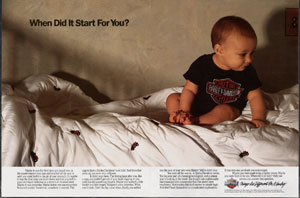 |
.. |
|
1990 Harley-Davidson Magazine Ad
When did it start for you? |
||
Harley-Davidson’s popularity grew to worldwide proportions in the end of the 1990’s which saw anew assembly facility opens in Manaus, Brazil, the first operations outside of the US And in 1997 anew 217,000-sq.-ft. Product Development Center opened next to the Capitol Drive plant in Milwaukee. The building is dedicated to Willie G. Davidson. Also the new 330,000-sq.-ft. plant in Kansas City produces its first Sportster.
Most likely the biggest event for H-D in the 1990’s was in 1993 Harley-Davidson celebrates its 90th Anniversary in Milwaukee with a Family Reunion. An estimated 100,000 people ride in a parade of motorcycles. And in 1998 Harley-Davidson celebrates its 95th Anniversary. 140,000 plus riders are warmly received by Milwaukee to help with the celebration.
At the end of 1999 the Touring and Dyna motorcycle families received the new Twin Cam 88 engine.
2000’s – R&D and Reflection.
The 90th and 95th Harley-Davidson Anniversary parties were big but in 2002 Harley-Davidson debuts The Open Road Tour in Atlanta, GA, in July to celebrate the upcoming Harley-Davidson 100th Anniversary. In 2003 more than 250,000 people came to Milwaukee for the final stop of the Open Road Tour and the Harley-Davidson 100th Anniversary Celebration and Party. It was a huge success.
Because of H-D’s huge brand success H-D could pour more money in R&D. Thus we saw in 2000 the FXSTD Softail Deuce and Softail models are outfitted with the Twin Cam 88B engine, a counterbalanced version of the Twin Cam 88. Also fuel injection is unveiled as a feature new to the Softail line of motorcycles for the 2001 model year. By 2001 the VRSCA V-Rod is introduced for the 2002 model year which was inspired by the VR-1000 racing motorcycle. The V-Rod is Harley-Davidson’s first motorcycle to combine fuel injection, overhead cams and liquid cooling which delivered 115 horsepower.
2006 the first of the 6-speed transmissions are made available on 2006 model year Dyna motorcycles. Also joining the Dyna family is the FXDB/I Street Bob. By 2006 the all-new FLHX/I Street Glide was introduced being a lower profile touring motorcycle.
With all the history and success, Harley-Davidson decided to reflect upon it’s past, present and future and unveiled plans for an all-new museum in Milwaukee, which opened in 2008.
What will the future bring for Harley-Davidson? More models, more innovations and more heritage products would be the easy answer. But Harley-Davidson faces a problem, how to attract the under 40 crowd to their models. The V-Rod is a good start, but it’s just a start. Recently Harley-Davidson discontinued it’s Buell line of motorcycles, a much-needed younger market magnet for the company and has also sold off it’s MV Agusta Italian motorcycle brand they acquired just over year ago. With it’s target market getting older all the time, H-D in the next 10-20 years will need to look at addressing this issue or be left behind and stuck in time.
A little bit of Harley-Davidson trivia:
What happened to the original factory “shed” that the founders started in?
The original factory survived into the 1970s and was kept at Juneau Avenue. At some point early in the decade, in a flurry of construction and renovation activity, the shed was accidentally torn down.
Why was the 50th anniversary celebrated with the 1954 model year motorcycles? Did someone regard 1904 as the first year?
A “50th birthday party” was held at the Capitol Drive plant in late summer of 1953 to celebrate the release of the 1954 anniversary models. However, the “Golden Anniversary” issue of The Enthusiast came out in September of 1953 and the magazine repeatedly referred to 1903 as the first year. Therefore, the timing of the 50th Anniversary celebration and the introduction of the 1954 model year was coincidental; the 1954 models were not 50th Anniversary models the way we now consider the 2003 models to be 100th Anniversary models. Anniversaries since 1953 have regarded 1903 as Harley-Davidson’s first year based on the year that the first motorcycle sale took place. This fact has been corroborated numerous times by original interviews with Company founders.
When did the association of eagle imagery with Harley-Davidson begin?
If you want to be technical about it, it goes back to 1933. That year, art deco gas tank logos were introduced to the public with a stylized soaring eagle. The more recent eagle with the “bar & shield” logo was introduced with the 1976 product line. That logo was created by Milwaukee artist Paul Smith.
What are the origins of the bar & shield logo?
According to the Archives, the earliest known use of the bar and shield is 1908, when it became available from the Company as a transfer decal to be used on the tool boxes found on Harley-Davidson(R) motorcycles. It was trademarked in 1910. It is not known for certain what inspired the choice of design or who created it.
Is it true that Harley-Davidson bought Elvis Presley’s KH from a farmer who found it in a barn?
No. The motorcycle was previously in the possession of Flemming Horne, a friend of Elvis’, who offered it to Harley-Davidson.
<< Page Back – Page Forward >>
 |
|
Harley-Davidson
|
If you would like Total Motorcycle, North America’s leading motorcycle information website to do a test ride and ride review of your motorcycle or scooter models just contact us for information or to book a date, location and time. It is a great way to promote your model and your company to over half a million visitors worldwide each month for no cost! Contact us today to inquire.


